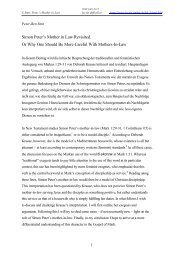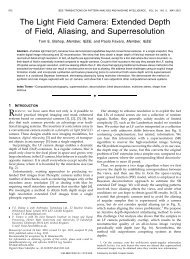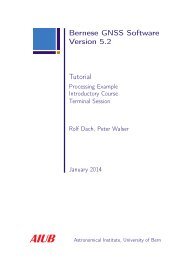Minimal Models of Adapted Neuronal Response to In Vivo–Like ...
Minimal Models of Adapted Neuronal Response to In Vivo–Like ...
Minimal Models of Adapted Neuronal Response to In Vivo–Like ...
Create successful ePaper yourself
Turn your PDF publications into a flip-book with our unique Google optimized e-Paper software.
Adapting Rate <strong>Models</strong> 2123<br />
Powers, R. K., Sawczuk, A., Musick, J. R., & Binder, M. D. (1999). Multiple mechanisms<br />
<strong>of</strong> spike-frequency adaptation in mo<strong>to</strong>neurones. J. Physiol. (Paris), 93,<br />
101–114.<br />
Press, W., Teukolsky, S. A., Vetterling, W. T., & Flannery, B. P. (1992). Numerical<br />
recipes in C: The art <strong>of</strong> scientific computing. Cambridge: Cambridge University<br />
Press.<br />
Rauch, A., La Camera, G., Lüscher, H.-R., Senn, W., & Fusi, S. (2003). Neocortical<br />
cells respond as integrate-and-fire neurons <strong>to</strong> in vivo–like input currents. J.<br />
Neurophysiol., 90, 1598–1612.<br />
Renart, A., Brunel, N., & Wang, X. J. (2003). Mean-field theory <strong>of</strong> recurrent<br />
cortical networks: From irregularly spiking neurons <strong>to</strong> working memory.<br />
<strong>In</strong> J. Feng (Ed.), Computational neuroscience: A comprehensive approach. Boca<br />
Ra<strong>to</strong>n, FL: CRC Press.<br />
Ricciardi, L. M. (1977). Diffusion processes and related <strong>to</strong>pics in biology. Berlin:<br />
Springer-Verlag.<br />
Sah, P. (1996). Ca 2+ -activated K + currents in neurons: Types, physiological roles<br />
and modulation. Trends Neurosci., 19, 150–154.<br />
Sanchez-Vives, M. V., Nowak, L. G., & McCormick, D. A. (2000). Cellular mechanisms<br />
<strong>of</strong> long-lasting adaptation in visual cortical neurons in vitro. J. Neuroscience,<br />
20, 4286–4299.<br />
Sawczuk, A., Powers, R. K., & Binder, M. D. (1997). Contribution <strong>of</strong> outward<br />
currents <strong>to</strong> spike frequency adaptation in hypoglossal mo<strong>to</strong>neurons <strong>of</strong> the<br />
rat. Journal <strong>of</strong> Physiology, 78, 2246–2253.<br />
Schwindt, P. C., & Crill, W. E. (1982). Fac<strong>to</strong>rs influencing mo<strong>to</strong>neuron rhythmic<br />
firing: Results from a voltage-clamp study. J. Neurophysiol., 48, 875–<br />
890.<br />
Schwindt, P., O’Brien, J. A., & Crill, W. E. (1997). Quantitative analysis <strong>of</strong> firing<br />
properties <strong>of</strong> pyramidal neurons from layer 5 <strong>of</strong> rat sensorimo<strong>to</strong>r cortex. J.<br />
Neurophysiol., 77, 2484–2498.<br />
Schwindt, P. C., Spain, W. J., & Crill, W. E. (1989). Long-lasting reduction <strong>of</strong><br />
excitability by a sodium-dependent potassium current in cat neocortical neurons.<br />
J. Neurophysiol., 61, 233–244.<br />
Shadlen, M. N., & Newsome, W. T. (1998). The variable discharge <strong>of</strong> cortical<br />
neurons: Implications for connectivity, computation and information coding.<br />
J. Neurosci., 18, 3870–3896.<br />
Shriki, O., Hansel, D., & Sompolinsky, H. (2003). Rate models for conductancebased<br />
cortical neural networks. Neural Computation, 15, 1809–1841.<br />
Siegert, A. J. F. (1951). On the first passage time probability function. Phys. Rev.,<br />
81, 617–623.<br />
Stafstrom, C. E., Schwindt, P. C., & Crill, W. E. (1984). Repetitive firing in layer<br />
V from cat neocortex in vitro. J. Neurophysiol., 52, 264–277.<br />
Traub, R. D., & Miles, R. (1991). <strong>Neuronal</strong> networks <strong>of</strong> the hippocampus. Cambridge:<br />
Cambridge University Press.<br />
Treves, A. (1993). Mean field analysis <strong>of</strong> neuronal spike dynamics. Network, 4,<br />
259–284.<br />
Tuckwell, H. C. (1988). <strong>In</strong>troduction <strong>to</strong> theoretical neurobiology. Cambridge: Cambridge<br />
University Press.
















